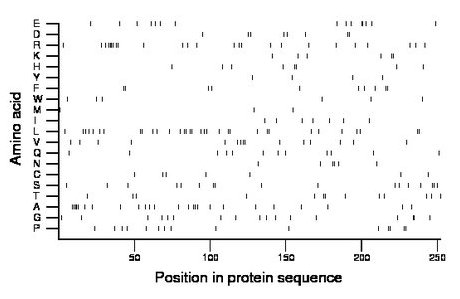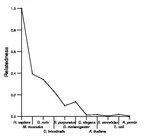
| Name: PLD6 | Sequence: fasta or formatted (252aa) | NCBI GI: 30520348 | |
|
Description: phospholipase D6
|
Referenced in:
| ||
|
Composition:

Amino acid Percentage Count Longest homopolymer A alanine 9.9 25 5 C cysteine 2.8 7 1 D aspartate 3.2 8 2 E glutamate 6.0 15 2 F phenylalanine 4.0 10 2 G glycine 6.7 17 2 H histidine 3.2 8 2 I isoleucine 2.8 7 1 K lysine 2.4 6 2 L leucine 13.1 33 2 M methionine 1.2 3 1 N asparagine 2.4 6 2 P proline 6.0 15 2 Q glutamine 4.8 12 1 R arginine 9.9 25 4 S serine 6.7 17 2 T threonine 5.2 13 2 V valine 6.0 15 2 W tryptophan 2.4 6 1 Y tyrosine 1.6 4 1 |
Comparative genomics:
Search single species RefSeq proteins at NCBI
Search summary 
Figure data | ||
Related human proteins:Protein Relative score Description Self-match 1.000 phospholipase D6 SNX26 0.029 sorting nexin 26 PLD4 0.022 phospholipase D4 PLD3 0.016 phospholipase D3 PLD3 0.016 phospholipase D3 SLIT3 0.014 slit homolog 3 FAM83A 0.014 hypothetical protein LOC84985 isoform b FAM83A 0.014 hypothetical protein LOC84985 isoform a FAM83H 0.012 FAM83H KDM4B 0.010 jumonji domain containing 2B FAM83D 0.010 hypothetical protein LOC81610 SCN2B 0.010 sodium channel, voltage-gated, type II, beta LAMA1 0.010 laminin, alpha 1 precursor FLT3 0.010 fms-related tyrosine kinase 3 FLT3LG 0.008 fms-related tyrosine kinase 3 ligand PARG 0.008 poly (ADP-ribose) glycohydrolase PROM1 0.006 prominin 1 isoform 2 PROM1 0.006 prominin 1 isoform 4 PROM1 0.006 prominin 1 isoform 5 PROM1 0.006 prominin 1 isoform 6 PROM1 0.006 prominin 1 isoform 7 PROM1 0.006 prominin 1 isoform 2 PROM1 0.006 prominin 1 isoform 1 UBE3A 0.006 ubiquitin protein ligase E3A isoform 3 UBE3A 0.006 ubiquitin protein ligase E3A isoform 1 UBE3A 0.006 ubiquitin protein ligase E3A isoform 2 LOC389857 0.006 PREDICTED: hypothetical proteinHuman BLASTP results (used to prepare the table) | |||
Gene descriptions are from NCBI RefSeq. Search results were obtained with NCBI BLAST and RefSeq entries. When identical proteins are present, the self-match may not be listed first in BLASTP output. In such cases, the table above has been reordered to place it first.
See About the Figures for the scoring system used in the figure above right. The same scoring system was used in the table of BLASTP results.
Guide to the Human Genome
Copyright © 2010 by Stewart Scherer. All rights reserved.
